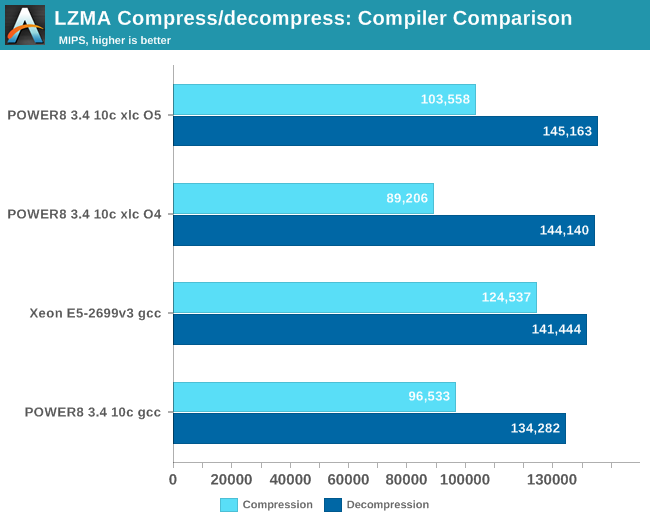The IBM POWER8 Review: Challenging the Intel Xeon
by Johan De Gelas on November 6, 2015 8:00 AM EST- Posted in
- IT Computing
- CPUs
- Enterprise
- Enterprise CPUs
- IBM
- POWER
- POWER8
Trying Out a Different Compiler: IBM's XLC
Based on our previous results the IBM POWER8 has definitely attracted our interest, and we were motivated to test a lot more. Can IBM's own compiler "XLC" boost the scores even more?
To test that out, we joined the IBM OpenPOWER Linux community and downloaded the IBM XLC compiler. We compiled with two different and rather aggressive settings:
- -qhot -O4 -qarch=pwr8
- -qhot -O5 -qarch=pwr8
We've taken our XLC binaries and set them up against binaries compiled with GCC 4.9.2 using the "-o3 -mcpu=power8" flag. The mcpu=power8 flag has very little impact on performance, but we wanted to be sure that GCC was given every opportunity to optimize for the POWER8 CPU.

The results for XLC are very weird. Using the -O4 flag the XLC compiler does pretty badly on compression (-7%), while increasing performance by 7% in decompression. Nothing to write home about. Only when we use the -O5 flag do we get an increase in performance by 7-8%. However we also found that -O5 was too aggressive for most complex software that we ported to the POWER8, and as a result isn't very usable.
We suspect that the XLC compiler for LE Linux is still a bit immature and has still some room to improve. Which unfortunately isn't doing IBM any favors at this moment since XLC is a paid compiler.










146 Comments
View All Comments
FunBunny2 - Friday, November 6, 2015 - link
"The z10 processor was co-developed with and shares many design traits with the POWER6 processor, such as fabrication technology, logic design, execution unit, floating-point units, bus technology (GX bus) and pipeline design style, i.e., a high frequency, low latency, deep (14 stages in the z10), in-order pipeline." from the Wiki.Yes, the z continues the CISC ISA from the 360 (well, sort of) rather than hardware RISC, but as Intel (amongst others) has demonstrated, CISC ISA doesn't have to be in hardware. In fact, the 360/30 (lowest tier) was wholly emulated, as was admitted then. Today, we'd say "micro-instructions". All those billions of transistors could have been used to implement X86 in hardware, but Intel went with emulation, sorry micro-ops.
What matters is the underlying fab tech. That's not going anywhere.
FunBunny2 - Friday, November 6, 2015 - link
^^ should have gone to KevinG!!Kevin G - Saturday, November 7, 2015 - link
The GX bus in the mainframes was indeed shared by POWER chips as that enabled system level component sharing (think chipsets).However, attributes like the execution unit and the pipeline depth are different between the POWER6 and z10. At a bird's eye view, they do look similar but the implementation is genuinely different.
Other features like SMT were introduced with the POWER5 but only the most recent z13 chip has 2 way SMT. Features like out-of-order execution, SMT, SIMD were once considered too exotic to validate in the mainframe market that needed absolute certainty in its hardware states. However, recent zArch chips have implemented these features, sometimes decades after being introduced in POWER.
The other thing is that IBM has been attempting to get get more and more of the zArch instruction set to be executed by hardware and no microcode. Roughly 75% to 80% of instructions are handled by microcode (there is a bit of a range here as some are conditional to use microcode).
JohanAnandtech - Saturday, November 7, 2015 - link
I believe that benchmark uses about 8 threads and not very well either? Secondly, it is probably very well optimized for SSE/AVX. So you can imagine that the POWER8 will not be very good at it, unless we manually optimize it for Altivec/VSX. And that is beyond my skills :-)UrQuan3 - Monday, December 21, 2015 - link
I'm sure no one is still reading this as I'm posting over a month later, but...I tested handbrake/x264 on a bunch of cross-platform builds including Raspberry Pi 2. I found it would take 24 RPi2s to match a single i5-4670K. That was a gcc compiled handbrake on Raspbian vs the heavily optimized DL copy for Windows. Not too bad really. Also, x264 seems to scale fairly well with the number of cores. Still, POWER8 unoptimized would be interesting, though not a fair test.
BTW, I'd encourage you to use a more standard Linux version than 6-month experimental little-endian version of Ubuntu. The slides you show advertise support for Ubuntu 14.04 LTS, not 15.04. For something this new, you may need the latest, but that is often not the case.
stun - Friday, November 6, 2015 - link
@Johan You might want to fix "the platform" hyperlink at the bottom of page 4. It is invalid.JohanAnandtech - Friday, November 6, 2015 - link
Thanks and fixed.Ahkorishaan - Friday, November 6, 2015 - link
Couldn't read past the graphic on page 1. It's 2015 IBM, time to use a font that doesn't look like a toddler's handwriting.xype - Sunday, November 8, 2015 - link
To be fair, it seems that the slide is meant for management types… :PJtaylor1986 - Friday, November 6, 2015 - link
Using decimals instead of commas to denote thousands is jarring to your North American readers.